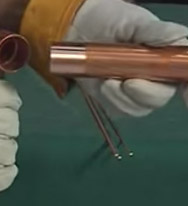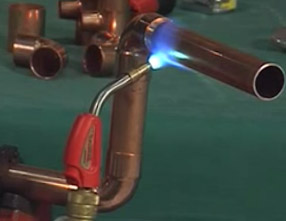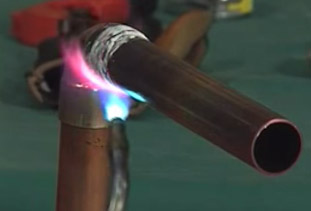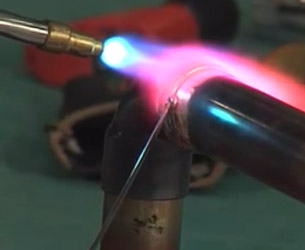The use of copper brazing is for when greater joint strength is needed or for systems that operate at 350 degrees or higher.
Typical uses include:
- Fire protection
- Air-conditioning and refrigeration
- Fuel gas distribution
- Water supplies
Both oxygen-bearing and oxygen-free copper can be brazed to produce a joint with satisfactory properties. The full strength of an annealed copper brazed joint will be developed with a lap joint.
The flame used should be slightly carburizing. All of the silver brazing alloys can be used with the proper fluxes. With the copper-phosphorous or copper-phosphorous-silver alloys, a brazed joint can be made without a flux, although the use of flux will result in a joint of better appearance.
Video Instructions for Brazing Copper Tube
Copper Soldering vs. Brazing
Most soldering is done at temperatures from 350 to 600 degrees. Copper brazing is done, such as for brazing joints at 1100 to 1500 degrees.
Copper Brazed Joints
Copper brazed joints are used when great joint strength is required or the system where the joints are used operates at greater than 350 degrees.
Butt, lap, and scarf joints are used in brazing operations, whether the joint members are flat, round, tubular, or of irregular cross sections.
Clearances to permit the penetration of the filler metal, except in large diameter pipe joints, should not be more than 0.002 to 0.003 in. (0.051 to 0.076 mm).
The clearances of large diameter pipe joinings may be 0.008 to 0.100 in. (0.203 to 2.540 mm).
The joint may be made with inserts of the filler metal or the filler metal may be fed in from the outside after the joint has been brought up to the proper temperature.
The scarf joint is used in joining bandsaws and for joints where the double thickness of the lap is not desired.
Instructions for Brazing Copper Tube
Complete all of these steps the same day. Watch the video at the top of this page for complete instructions.
- Mark the tube for the proper length.
- Cut the tube using a hacksaw, tube cutter or other personally preferred methods.
- Ream the ends of the cut tube to remove any metal spurs. Tools that can ream the tube include a reaming blade (found on tube cutters), a half-round file or a deburring tool
- Prepare the joints by cleaning areas to be soldered to remove any oxides and oil. Use a sand cloth or abrasive pad. The space between the tube and fitting should be .004 in.
Preparation for Copper Brazing by Testing Pipe Fit. - Insert the tube onto the fitting to ensure a snug fit, but that also leaves enough room for the capillary action of the solder. About .0004 inches. Turn the tube if possible. Firmly support the tube.
Brazing Copper Pipe - Hold the flame perpendicular to the tube and preheat both the tube and the fitting cup. Do not overheat since this could cause the flux to burn. Preferably use an oxyfuel torch with a neutral flame. Keep the flame in motion and do not linger on any one part of the tube.If using a flux to remove and dissolve any oxide use gloves, do not apply with bare hands. Keep away from cuts, the mouth, and eyes.Note that when brazing copper tube to wrot copper fittings using a BCuP brazing alloy, brazing flux can be used but is not necessary.
When using a flux heat it uniformly until the flux becomes transparent (follow the manufacturer’s directions).
Note that is is harder to keep the required uniform temperature on tubes with a larger circumference. Preheating of the entire fitting is needed. A second torch can also help to maintain the heat needed.
- Touch the filler metal to the joint which should start to melt. Apply at the point where the tube enters the socket of the fitting. When the filler metal melts, apply the heat source to the base of the cup. If a joint is in a horizontal position apply solder slightly off center at the bottom. Push solder straight into the joint, while keeping the torch at the base of the fitting and just ahead of the point of solder application. (see video above)Keep the flame away from the filler metal. The temperature of the joint itself should melt the filler metal. The flame should be slight ahead of the filler metal application.Follow the same procedure for joints that are vertical.
Stop heating as soon as you see a complete fillet.
- Allow the joint to cool without the use of water. After cooling, clean off any flux with a damp rag.
Note that some brazing installations such as medical gas and ACR systems require the use of an inert gas during the copper brazing process.
This eliminates the possibility of oxide formation on the interior tube surface.



